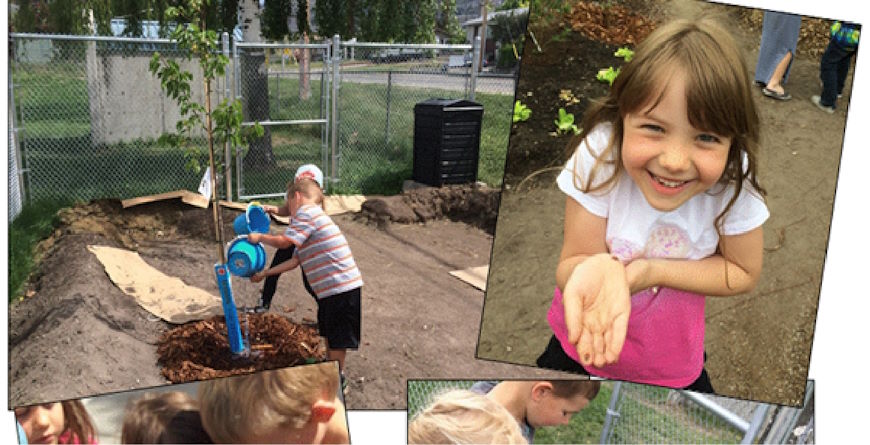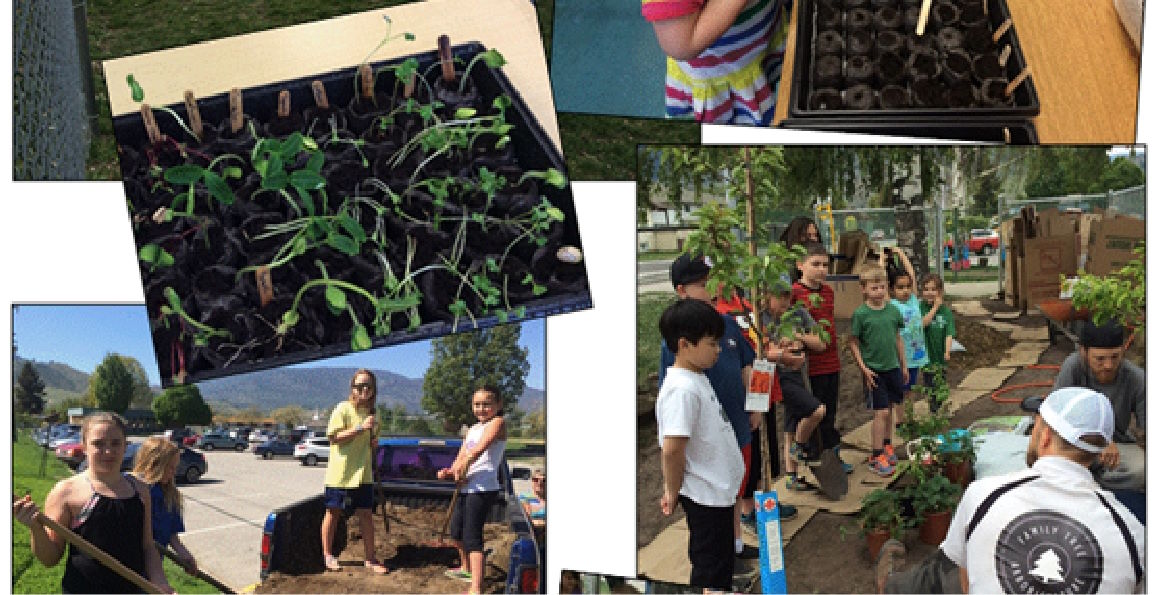Parkway has approximately 250 students and includes lower social economic families. Our school grounds are primarily green fields with few trees and no other environmental diversity in our play spaces. We recognized our school had a nature deficit and a lack of respect for our school grounds.
If students help build a food forest garden and, in that garden, learn how to plant, maintain, harvest and eat produce, how will students’ relationship with the environment and their knowledge of healthy eating change?
Our project involved three CSH pillars: Teaching and Learning, Relationships and Environments and Community Partnerships.
Through connections made with our Farm to School Grant, we planned the Food Forest Garden. Ryan Foster with Food Forestry Canada was instrumental in bringing my vision to life. We designed a place where children can play and learn amongst trees, shrubs and plants. The 1800 square foot garden will grow into a self-sustaining food forest.
Early in the spring, students learned about plants and planted over 120 seeds. Dylan Nielson-Schenk and his crew from Family Tree Arboriculture, Ryan Foster as well as a team from Superstore volunteered their time to do the heavy work in the garden and taught students to plant seedlings. All 250 Parkway students planted at least one seedling.
We reached out to the community and received an overwhelming amount of support from the following:
- Rona
- Canadian Tire
- JCI Penticton
- Family Tree Arboriculture
- Superstore
- Parkway PAC
- School District 67
- Sandstone Landscape Supplies
- Home Hardware
- Bylands Nursery
- Flowers on the Bench
- Westminster Rentals
All students, teachers and CEAs had a tour to learn about the garden. They learned which plants were edible and that all parts of edible plants are not to be eaten. They practiced harvesting lettuce and herbs sustainably and learned how to return uneaten plants to the earth by composting. Since the garden tours, students have been able to visit the garden without their teachers to tidy, taste and play.
Teachers have shared produce with their classes. One class picked their own greens and made their own mint strawberry dressing to enjoy on their salad. Another class picked a huge zucchini to taste.
The food forest garden has fostered a dialogue on healthy eating and caring for our earth. Neighbours who previously walked by without a glance now stop by and encourage children in their endeavors. Students are excited and talking to each other about the seedlings they have planted and are watching their growth.
Students are transferring the knowledge they have gained to others. When our School Board Trustees attended the Grand Opening of the garden, students were able to teach them which plants were edible and how to pick produce sustainably.
Students come to the garden to discover, explore and create. Students come back to class more centered and ready to learn. In class, students have new experiences from the garden to draw on and are able to connect to learning in a very personal way. On a visit to the En’owkin Centre, a centre for aboriginal learning, students were able to connect their learning in the garden to many of the aboriginal teachings.
My professional learning during this project has been focused on children’s need for healthy eating, nature, outside play and a connection to the land. I learned that a food forest can provide opportunities to teach (and for students to discover) about these things. A food forest is a place to play, create, discover and reflect. Food forests lend themselves to aboriginal teachings, to self-sustainable living, to taking care of yourself and your community.
For the next garden, there are things I would approach differently but many things I would keep the same. First, I would only consider a site that is in full view of the community; students love the feedback they get from neighbours and we have secured many volunteers due to our visibility. Second, I would include a watering system in the initial planning stages. We are currently hand watering from school taps and will be working on a drip system from rain barrels in order to maintain nutrient levels in the soil. Third, I would have experts plant my trees and shrubs again to ensure it was done correctly.
I will continue to be involved with the garden to ensure it is well established and to offer ideas and inspiration to keep Parkway teachers involved. I will consult with schools in our district that are interested in starting a garden like ours. In a few years hope to work at my neighbourhood school where I will propose we build a food forest for students and the community.
The School Food Literacy Capacity Building Initiative helped us build our food forest garden which has allowed me to deepen my teaching practices with hands on experiences. When my class learns in the garden, the students are able to put their whole hearts and minds into recording their discoveries, connections and wonders.


